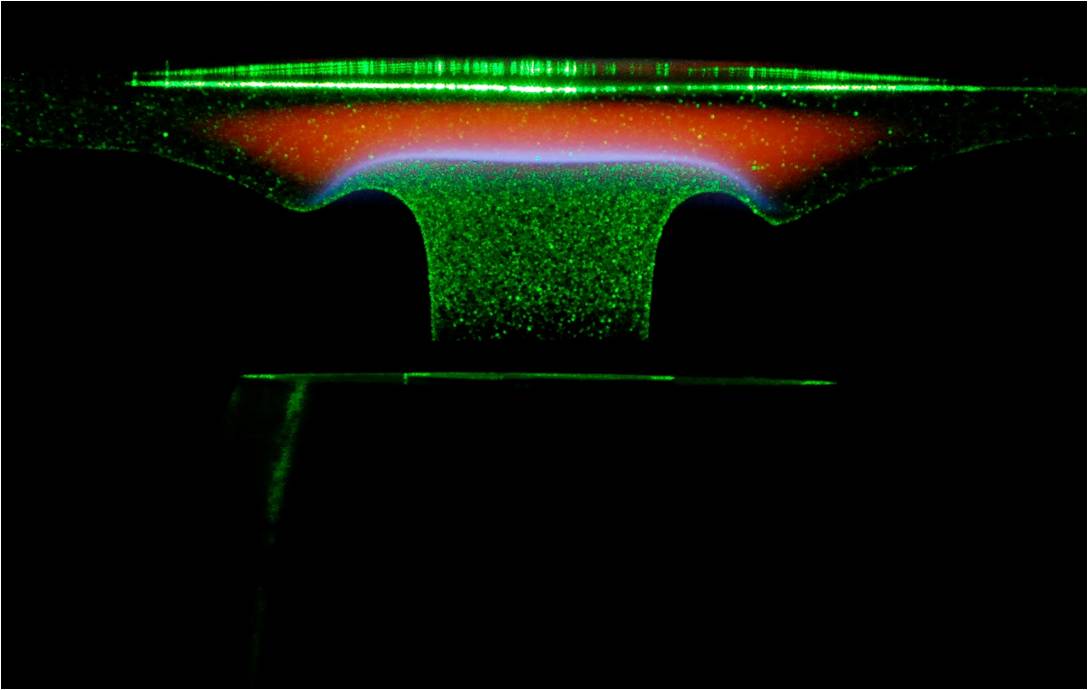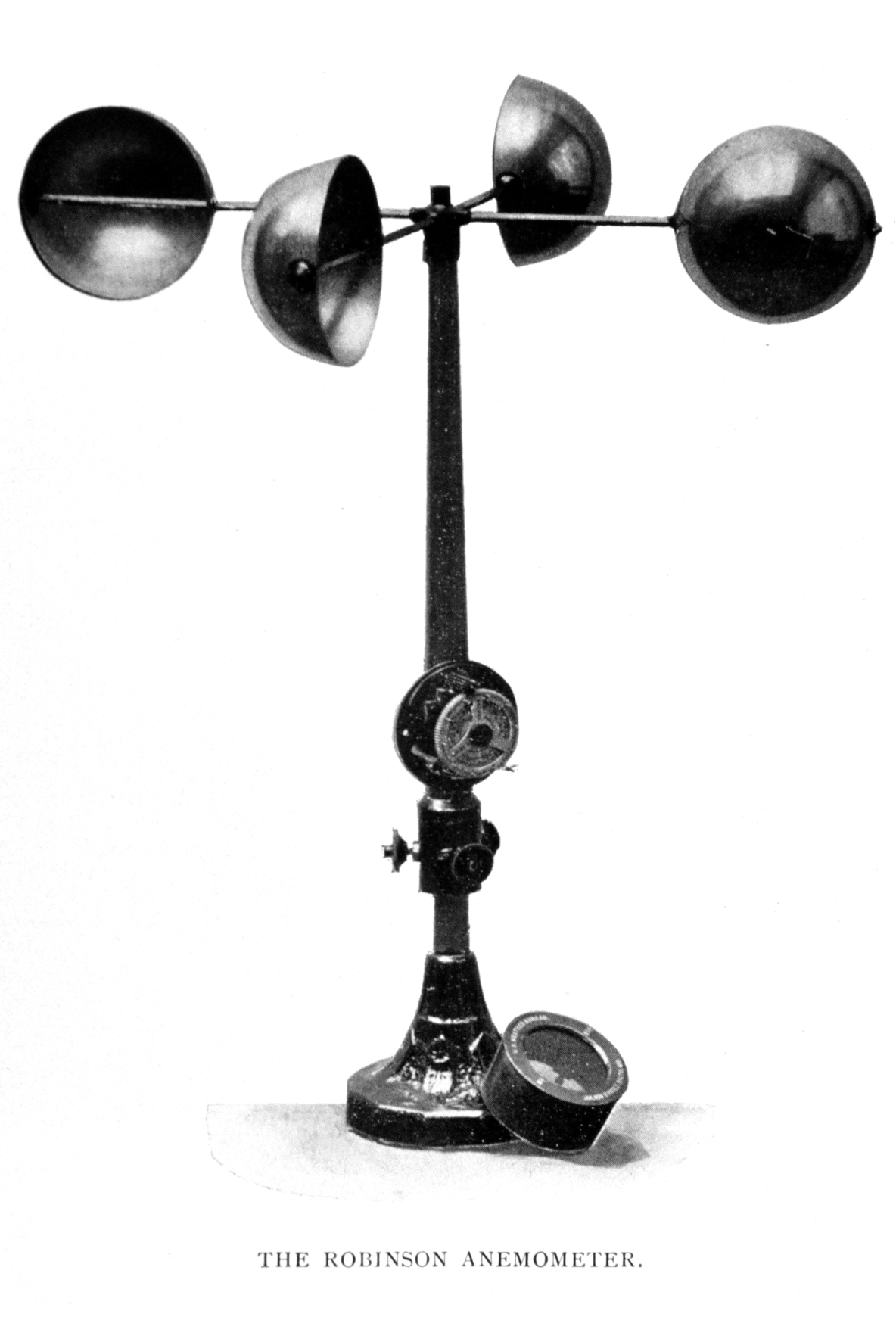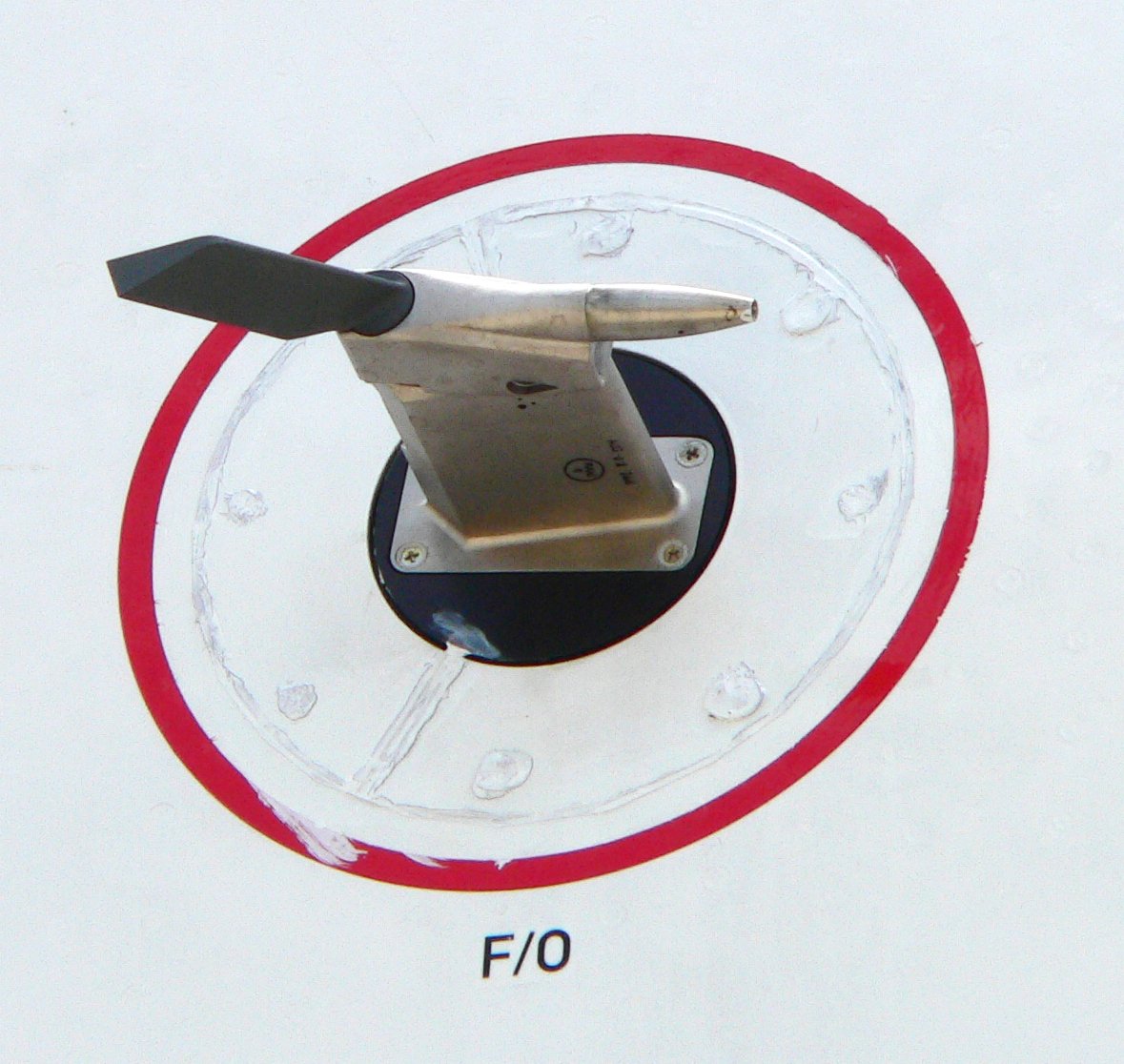|
Molecular Tagging Velocimetry
Molecular tagging velocimetry (MTV) is a specific form of flow velocimetry, a technique for determining the velocity of currents in fluids such as air and water. In its simplest form, a single "write" laser beam is shot once through the sample space. Along its path an optically induced chemical process is initiated, resulting in the creation of a new chemical species or in changing the internal energy state of an existing one, so that the molecules struck by the laser beam can be distinguished from the rest of the fluid. Such molecules are said to be "tagged". This line of tagged molecules is now transported by the fluid flow. To obtain velocity information, images at two instances in time are obtained and analyzed (often by correlation of the image intensities) to determine the displacement. If the flow is three-dimensional or turbulent the line will not only be displaced, it will also be deformed. Description There are three optical ways via which these tagged molecules can be v ... [...More Info...] [...Related Items...] OR: [Wikipedia] [Google] [Baidu] |
Laser Doppler Velocimetry
Laser Doppler velocimetry, also known as laser Doppler anemometry, is the technique of using the Doppler shift in a laser beam to measure the velocity in transparent or semi-transparent fluid flows or the linear or vibratory motion of opaque, reflecting surfaces. The measurement with laser Doppler anemometry is absolute and linear with velocity and requires no pre-calibration. Technology origin The development of the helium–neon laser (He-Ne) in 1962 at the Bell Telephone Laboratories provided the optics community with a continuous wave electromagnetic radiation source that was highly concentrated at a wavelength of 632.8 nanometers (nm) in the red portion of the visible spectrum. It was discovered that fluid flow measurements could be made using the Doppler effect on a He-Ne beam scattered by small polystyrene spheres in the fluid. At the Research Laboratories of Brown Engineering Company (later Teledyne Brown Engineering), this phenomenon was used to develop the first laser D ... [...More Info...] [...Related Items...] OR: [Wikipedia] [Google] [Baidu] |
Particle Image Velocimetry
Particle image velocimetry (PIV) is an optical method of flow visualization used in education and research. It is used to obtain instantaneous velocity measurements and related properties in fluids. The fluid is seeded with tracer particles which, for sufficiently small particles, are assumed to faithfully follow the flow dynamics (the degree to which the particles faithfully follow the flow is represented by the Stokes number). The fluid with entrained particles is illuminated so that particles are visible. The motion of the seeding particles is used to calculate speed and direction (the velocity field) of the flow being studied. Other techniques used to measure flows are laser Doppler velocimetry and hot-wire anemometry. The main difference between PIV and those techniques is that PIV produces two-dimensional or even three-dimensional vector fields, while the other techniques measure the velocity at a point. During PIV, the particle concentration is such that it is possibl ... [...More Info...] [...Related Items...] OR: [Wikipedia] [Google] [Baidu] |
Laser-induced Fluorescence
Laser-induced fluorescence (LIF) or laser-stimulated fluorescence (LSF) is a spectroscopic method in which an atom or molecule is excited to a higher energy level by the absorption of laser light followed by spontaneous emission of light. It was first reported by Zare and coworkers in 1968. LIF is used for studying structure of molecules, detection of selective species and flow visualization and measurements. The wavelength is often selected to be the one at which the species has its largest cross section. The excited species will after some time, usually in the order of few nanoseconds to microseconds, spontaneously decay and emit a photon at a wavelength longer than the excitation wavelength. This fluorescent light is typically recorded with a photomultiplier tube (PMT), charged-coupled device (CCD), or filtered photodiodes. Types Two different kinds of spectra exist, disperse spectra and excitation spectra. The disperse spectra are performed with a fixed lasing wavelength, ... [...More Info...] [...Related Items...] OR: [Wikipedia] [Google] [Baidu] |
Hot-wire Anemometry
In meteorology, an anemometer () is a device that measures wind speed and direction. It is a common instrument used in weather stations. The earliest known description of an anemometer was by Italian architect and author Leon Battista Alberti (1404–1472) in 1450. History The anemometer has changed little since its development in the 15th century. Alberti is said to have invented it around 1450. In the ensuing centuries numerous others, including Robert Hooke (1635–1703), developed their own versions, with some mistakenly credited as its inventor. In 1846, Thomas Romney Robinson (1792–1882) improved the design by using four hemispherical cups and mechanical wheels. In 1926, Canadian meteorologist John Patterson (1872–1956) developed a three-cup anemometer, which was improved by Brevoort and Joiner in 1935. In 1991, Derek Weston added the ability to measure wind direction. In 1994, Andreas Pflitsch developed the sonic anemometer. Velocity anemometers Cup anemometers ... [...More Info...] [...Related Items...] OR: [Wikipedia] [Google] [Baidu] |
Photochromism
Photochromism is the reversible change of color upon exposure to light. It is a transformation of a chemical species (photoswitch) between two forms through the absorption of electromagnetic radiation (photoisomerization), where each form has a different absorption spectrum. This reversible structural or geometric change in photochromic molecules affects their electronic configuration, molecular strain energy, and other properties. History In 1867, Carl Julius Fritzsche reported the concept of photochromism, indicating that orange tetracene solution lost its color in daylight but regained it in darkness. Later, similar behavior was observed by both Edmund ter Meer and Phipson. Ter Meer documented the color change of the potassium salt of dinitroethane, which appeared red in daylight and yellow in the dark. Phipson also recorded that a painted gatepost appeared black during the day and white at night due to a zinc pigment, likely lithopone. In 1899, Willy Markwald, who studied th ... [...More Info...] [...Related Items...] OR: [Wikipedia] [Google] [Baidu] |
Hydroxyl Tagging Velocimetry
Hydroxyl tagging velocimetry (HTV) is a velocimetry method used in humid air flows. The method is often used in high-speed combusting flows because the high velocity and temperature accentuate its advantages over similar methods. HTV uses a laser (often an argon-fluoride excimer laser operating at ~193 nm) to dissociate the water in the flow into H + OH. Before entering the flow optics are used to create a grid of laser beams. The water in the flow is dissociated only where beams of sufficient energy pass through the flow, thus creating a grid in the flow where the concentrations of hydroxyl (OH) are higher than in the surrounding flow. Another laser beam (at either ~248 nm or ~308 nm) in the form of a sheet is also passed through the flow in the same plane as the grid. This laser beam is tuned to a wavelength that causes the hydroxyl molecules to fluoresce in the UV spectrum. The fluorescence is then captured by a charge-coupled device (CCD) camera. Using elec ... [...More Info...] [...Related Items...] OR: [Wikipedia] [Google] [Baidu] |
Nitric Oxide
Nitric oxide (nitrogen oxide, nitrogen monooxide, or nitrogen monoxide) is a colorless gas with the formula . It is one of the principal oxides of nitrogen. Nitric oxide is a free radical: it has an unpaired electron, which is sometimes denoted by a dot in its chemical formula (•N=O or •NO). Nitric oxide is also a heteronuclear diatomic molecule, a class of molecules whose study spawned early modern theories of chemical bonding. An important intermediate in industrial chemistry, nitric oxide forms in combustion systems and can be generated by lightning in thunderstorms. In mammals, including humans, nitric oxide is a signaling molecule in many physiological and pathological processes. It was proclaimed the " Molecule of the Year" in 1992. The 1998 Nobel Prize in Physiology or Medicine was awarded for discovering nitric oxide's role as a cardiovascular signalling molecule. Its impact extends beyond biology, with applications in medicine, such as the development of ... [...More Info...] [...Related Items...] OR: [Wikipedia] [Google] [Baidu] |
Hot-wire Velocimetry , a Radical Comics series by Warren Ellis and Steve Pugh
{{disambig ...
Hotwire or hot wire may refer to: Technology * Hot-wiring, a method of starting a car with no key * Hot-wire foam cutter, a tool used to cut foam and polystyrene * Hot wire (electricity), a wire conductor with non-zero potential in electric power distribution * Hot-wire anemometer, an electrical device for measuring the speed of airflow Music * Hotwire (band) * ''Hot Wire'' (Trapeze album), 1974 * ''Hot Wire'' (Kix album), 1991 *''Hot Wires'', a 1987 album by Roy Buchanan Other * Hotwire.com, an Internet-based travel agency * ''HotWired'', an internet magazine *Hotwire (comics) ''Hotwire'' is a comics series created by Steve Pugh, with later writing credits by Warren Ellis. Publication history ''Hotwire'' was a project originally slated to be published by Tundra UK back in the early 1990s. Hotwire first appeared as a ... [...More Info...] [...Related Items...] OR: [Wikipedia] [Google] [Baidu] |
Pitot Tube
A pitot tube ( ; also pitot probe) measures fluid flow velocity. It was invented by French engineer Henri Pitot during his work with aqueducts and published in 1732, and modified to its modern form in 1858 by Henry Darcy. It is widely used to determine the airspeed of aircraft; the water speed of boats; and the flow velocity of liquids, air, and gases in industry. Theory of operation The basic pitot tube consists of a tube pointing directly into the oncoming fluid flow. Pressure in the tube can be measured as the moving fluid cannot escape and stagnates. This pressure is the stagnation pressure of the fluid, also known as the total pressure or (particularly in aviation) the pitot pressure. The measured stagnation pressure cannot just by itself be used to determine the fluid flow velocity (airspeed in aviation) directly. However, with a measured static pressure as well it can be determined by the use of Bernoulli's equation which states: :Stagnation pressure = static pr ... [...More Info...] [...Related Items...] OR: [Wikipedia] [Google] [Baidu] |
Jet Engine
A jet engine is a type of reaction engine, discharging a fast-moving jet (fluid), jet of heated gas (usually air) that generates thrust by jet propulsion. While this broad definition may include Rocket engine, rocket, Pump-jet, water jet, and hybrid propulsion, the term typically refers to an internal combustion airbreathing jet engine, air-breathing jet engine such as a turbojet, turbofan, ramjet, pulse jet engine, pulse jet, or scramjet. In general, jet engines are internal combustion engines. Air-breathing jet engines typically feature a Axial compressor, rotating air compressor powered by a turbine, with the leftover power providing thrust through the propelling nozzle—this process is known as the Brayton cycle, Brayton thermodynamic cycle. Jet aircraft use such engines for long-distance travel. Early jet aircraft used turbojet engines that were relatively inefficient for subsonic flight. Most modern subsonic jet aircraft use more complex High-bypass turbofan, high-bypas ... [...More Info...] [...Related Items...] OR: [Wikipedia] [Google] [Baidu] |



